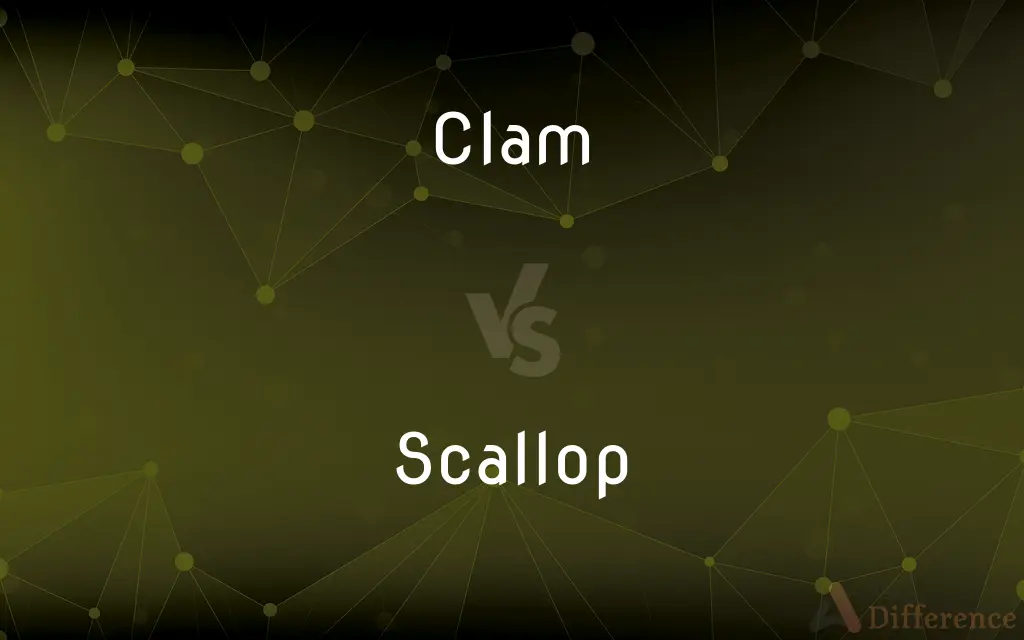Clam vs. Scallop — What's the Difference?
By Tayyaba Rehman & Fiza Rafique — Updated on September 10, 2023
A clam is a bivalve mollusk that burrows in the sand and primarily filters water for nutrients. A scallop is also a bivalve but can swim by rapidly opening and closing its shell, and it typically lives free on the ocean floor.

Difference Between Clam and Scallop
Table of Contents
ADVERTISEMENT
Key Differences
Clams and scallops are both bivalve mollusks, meaning they have two shells that protect their soft bodies. However, the two are quite different in their habitats and behaviors. Clams are generally found burrowed in the sand or mud, where they filter-feed on plankton and other microscopic organisms. Scallops, on the other hand, are often found lying on the seabed or attached to objects, and they are capable of swimming short distances by rapidly opening and closing their shells.
The shape of the shell is another distinguishing feature between clams and scallops. Clam shells are usually more rounded and may have ridges, while scallop shells are more uniformly flat and feature a fan-like pattern. The shells of both creatures serve as protection, but the shape of the scallop shell is more optimized for its swimming behavior.
Clams are generally more sedentary creatures, content to stay in one place and filter-feed. They can move by using their "foot," a muscular organ, but this is usually for short distances and primarily for burrowing. Scallops are more mobile; they can "swim" by clapping their shells together, expelling water, and propelling themselves forward.
Both clams and scallops are harvested for food and are popular seafood items. However, the parts eaten differ: For clams, it's usually the muscle that is consumed, whereas for scallops, the adductor muscle (used for opening and closing the shell) is the primary part that's eaten. Each has a distinct flavor and texture, with scallops being generally sweeter and more tender than clams.
Comparison Chart
Habitat
Burrowed in sand/mud
On seabed/free-swimming
ADVERTISEMENT
Mobility
Sedentary
Mobile
Shell Shape
Rounded, may have ridges
Flat, fan-like pattern
Edible Part
Muscle
Adductor muscle
Feeding Method
Filter-feeder
Filter-feeder
Compare with Definitions
Clam
A bivalve mollusk that burrows in the sand and filters water for food.
The clam was found buried in the beach sand.
Scallop
A bivalve mollusk capable of swimming by opening and closing its shell.
The scallop swam away when it sensed danger.
Clam
An animal that can produce pearls in certain species.
The pearl came from a type of clam.
Scallop
A seafood delicacy known for its sweet, tender meat.
The scallop dish was the highlight of the meal.
Clam
A popular seafood item typically served steamed or in chowders.
I ordered a bowl of clam chowder.
Scallop
An animal that lives freely on the seabed or attaches to objects.
This scallop was found attached to a piece of coral.
Clam
A creature characterized by its two shells and sedentary lifestyle.
The clam stayed in the same spot for weeks.
Scallop
An organism that feeds by filtering plankton and other particles from the water.
The scallop feeds by filtering water through its gills.
Clam
An organism that moves using a muscular "foot" for burrowing.
The clam used its foot to dig into the sand.
Scallop
A creature characterized by its fan-like shell pattern.
The scallop's shell had a beautiful fan-like design.
Clam
Clam is a common name for several kinds of bivalve molluscs. The word is often applied only to those that are edible and live as infauna, spending most of their lives halfway buried in the sand of the seafloor or riverbeds.
Scallop
Scallop () is a common name that is primarily applied to any one of numerous species of saltwater clams or marine bivalve mollusks in the taxonomic family Pectinidae, the scallops. However, the common name "scallop" is also sometimes applied to species in other closely related families within the superfamily Pectinoidea, which also includes the thorny oysters.
Clam
A marine bivalve mollusc with shells of equal size.
Scallop
An edible bivalve mollusc with a ribbed fan-shaped shell. Scallops swim by rapidly opening and closing the shell valves.
Clam
A dollar.
Scallop
Each of a series of convex rounded projections forming an ornamental edging cut in material or worked in lace or knitting in imitation of the edge of a scallop shell
An intricate design of vees and scallops
The tablecloth has a scallop edge
Clam
Dig for or collect clams
November is one of the worst times for clamming
Scallop
Another term for escalope
Clam
Abruptly stop talking
As soon as I ask if any of this can go on the record, he clams up
Scallop
Ornament (an edge or material) with scallops
The beaded lace overlay scalloped the neckline of the dress
Clam
Any of various usually burrowing marine and freshwater bivalve mollusks chiefly of the subclass Heterodonta, including members of the families Veneridae and Myidae, many of which are edible.
Scallop
Gather or dredge for scallops
In fall and early winter they went scalloping
Clam
The soft edible body of such a mollusk.
Scallop
Bake with milk or a sauce
The potatoes were scalloped with green peppers, onions, and herbs
Clam
(Informal) A close-mouthed person, especially one who can keep a secret.
Scallop
Any of various marine bivalve mollusks of the family Pectinidae, having fan-shaped shells with a radiating fluted pattern.
Clam
(Slang) A dollar
Owed them 75 clams.
Scallop
The edible adductor muscle of a scallop.
Clam
A clamp or vise.
Scallop
A shell of a scallop, or a dish in a similar shape, used for baking and serving seafood.
Clam
To hunt for clams.
Scallop
One of a series of curved projections forming an ornamental border.
Clam
A bivalve mollusk of many kinds, especially those that are edible; for example pl=s (Mya arenaria), hard clams (Mercenaria mercenaria), sea clams or hen clam (Spisula solidissima), and other species. The name is said to have been given originally to the Tridacna gigas, a huge East Indian bivalve.
Scallop
See escalope.
Clam
Strong pincers or forceps.
Scallop
To edge (cloth, for example) with a series of curved projections.
Clam
A kind of vise, usually of wood.
Scallop
To bake in a casserole with milk or a sauce and often with bread crumbs
Scalloped potatoes.
Clam
A dollar.
Those sneakers cost me fifty clams!
Scallop
To cut (meat) into thin boneless slices.
Clam
A Scientologist.
Scallop
To gather scallops for eating or sale.
Clam
A vagina.
Scallop
Any of various marine bivalve molluscs of the family Pectinidae which are free-swimming.
Clam
(slang) In musicians' parlance, a wrong or misplaced note.
Scallop
One of a series of curves, forming an edge similar to a scallop shell, especially in knitting and crochet.
Clam
(informal) One who clams up; a taciturn person, one who refuses to speak.
Scallop
(cooking) A fillet of meat, escalope.
Clam
Mouth (Now found mostly in the expression shut one's clam)
Scallop
(cooking) A form of fried potato.
Clam
Clamminess; moisture
Scallop
A dish shaped like a scallop shell.
Clam
To dig for clams.
Scallop
To create or form an edge in the shape of a crescent or multiple crescents.
Clam
To produce, in bellringing, a clam or clangor; to cause to clang.
Scallop
(transitive) To bake in a casserole (gratin), originally in a scallop shell; especially used in form scalloped
Clam
To be moist or glutinous; to stick; to adhere.
Scallop
(intransitive) To harvest scallops
Clam
To clog, as with glutinous or viscous matter.
Scallop
Any one of numerous species of marine bivalve mollusks of the genus Pecten and allied genera of the family Pectinidæ. The shell is usually radially ribbed, and the edge is therefore often undulated in a characteristic manner. The large adductor muscle of some the species is much used as food. One species (Vola Jacobæus) occurs on the coast of Palestine, and its shell was formerly worn by pilgrims as a mark that they had been to the Holy Land. Called also fan shell. See Pecten, 2.
Clam
Clammy.
Scallop
One of series of segments of circles joined at their extremities, forming a border like the edge or surface of a scallop shell.
Clam
A bivalve mollusk of many kinds, especially those that are edible; as, the long clam (Mya arenaria), the quahog or round clam (Venus mercenaria), the sea clam or hen clam (Spisula solidissima), and other species of the United States. The name is said to have been given originally to the Tridacna gigas, a huge East Indian bivalve.
You shall scarce find any bay or shallow shore, or cove of sand, where you may not take many clampes, or lobsters, or both, at your pleasure.
Clams, or clamps, is a shellfish not much unlike a cockle; it lieth under the sand.
Scallop
One of the shells of a scallop; also, a dish resembling a scallop shell.
Clam
Strong pinchers or forceps.
Scallop
To bake in scallop shells or dishes; to prepare with crumbs of bread or cracker, and bake. See Scalloped oysters, below.
Clam
A kind of vise, usually of wood.
Scallop
One of a series of rounded projections (or the notches between them) formed by curves along an edge (as the edge of a leaf or piece of cloth or the margin of a shell or a shriveled red blood cell observed in a hypertonic solution etc.)
Clam
Claminess; moisture.
Scallop
Edible muscle of mollusks having fan-shaped shells; served broiled or poached or in salads or cream sauces
Clam
A crash or clangor made by ringing all the bells of a chime at once.
Scallop
Thin slice of meat (especially veal) usually fried or broiled
Clam
To clog, as with glutinous or viscous matter.
A swarm of wasps got into a honey pot, and there they cloyed and clammed Themselves till there was no getting out again.
Scallop
Edible marine bivalve having a fluted fan-shaped shell that swim by expelling water from the shell in a series of snapping motions
Clam
To be moist or glutinous; to stick; to adhere.
Scallop
Decorate an edge with scallops;
The dress had a scalloped skirt
Clam
To produce, in bell ringing, a clam or clangor; to cause to clang.
Scallop
Form scallops in;
Scallop the meat
Clam
Burrowing marine mollusk living on sand or mud
Scallop
Fish for scallops
Clam
A piece of paper money worth one dollar
Scallop
Shape or cut in scallops;
Scallop the hem of the dress
Clam
Flesh of either hard-shell or soft-shell clams
Clam
Gather clams, by digging in the sand by the ocean
Common Curiosities
What is a clam?
A clam is a bivalve mollusk that typically burrows in sand and filter-feeds.
Do clams and scallops have shells?
Yes, both have two shells that protect their soft bodies.
How do scallops move?
Scallops can "swim" by rapidly opening and closing their shells.
What is a scallop?
A scallop is a bivalve mollusk that can swim and lives freely on the seabed.
How do clams move?
Clams move by using a muscular "foot" mainly for burrowing.
Where do clams live?
Clams usually live burrowed in sand or mud.
Are clams and scallops filter-feeders?
Yes, both are filter-feeders that consume plankton and other small particles.
What part of clams is typically eaten?
Usually, the muscle of the clam is consumed.
Are clams and scallops popular seafood items?
Yes, both are popular and have distinct flavors and textures.
Where do scallops live?
Scallops are usually found on the seabed and can be free-swimming or attached to objects.
Do scallops have a unique shell pattern?
Yes, scallop shells have a distinct fan-like pattern.
What part of scallops is typically eaten?
The adductor muscle is the primary part eaten in scallops.
Are clams generally mobile?
No, clams are generally sedentary and remain in one place.
Can clams produce pearls?
Yes, some species of clams can produce pearls.
Are scallops generally mobile?
Yes, scallops are more mobile and can move by "swimming."
Share Your Discovery

Previous Comparison
Freight vs. Cartage
Next Comparison
Confrontative vs. ConfrontationalAuthor Spotlight
Written by
Tayyaba RehmanTayyaba Rehman is a distinguished writer, currently serving as a primary contributor to askdifference.com. As a researcher in semantics and etymology, Tayyaba's passion for the complexity of languages and their distinctions has found a perfect home on the platform. Tayyaba delves into the intricacies of language, distinguishing between commonly confused words and phrases, thereby providing clarity for readers worldwide.
Co-written by
Fiza RafiqueFiza Rafique is a skilled content writer at AskDifference.com, where she meticulously refines and enhances written pieces. Drawing from her vast editorial expertise, Fiza ensures clarity, accuracy, and precision in every article. Passionate about language, she continually seeks to elevate the quality of content for readers worldwide.
















































